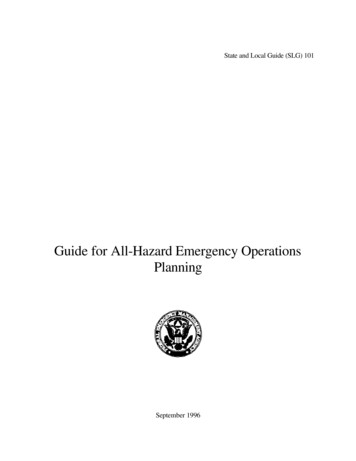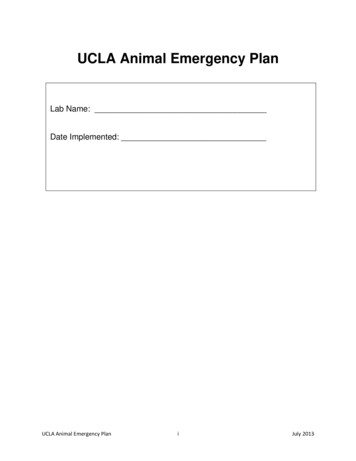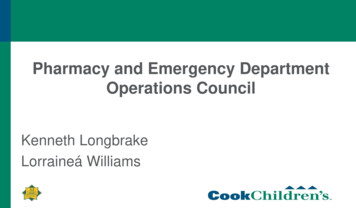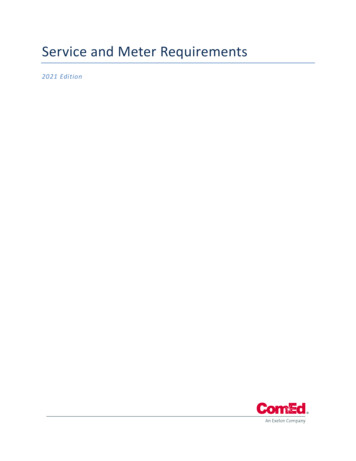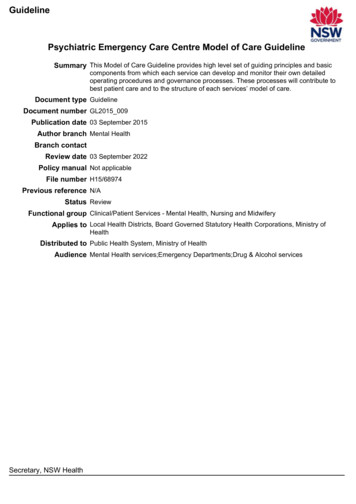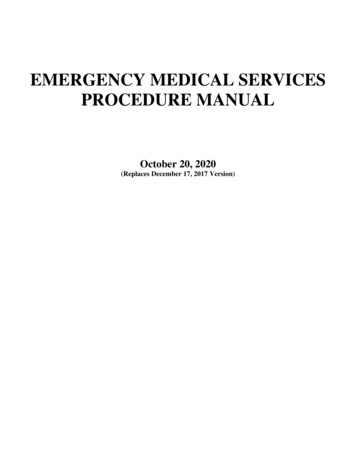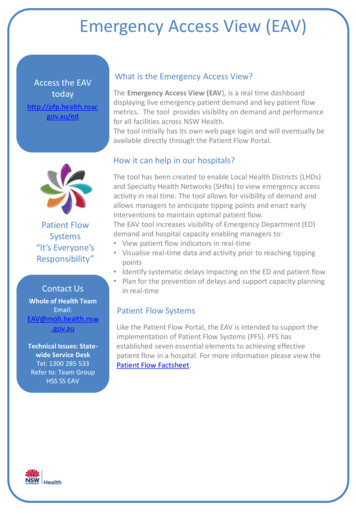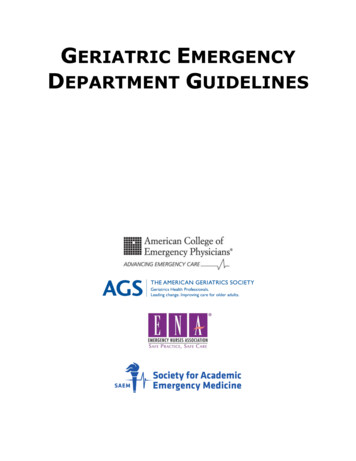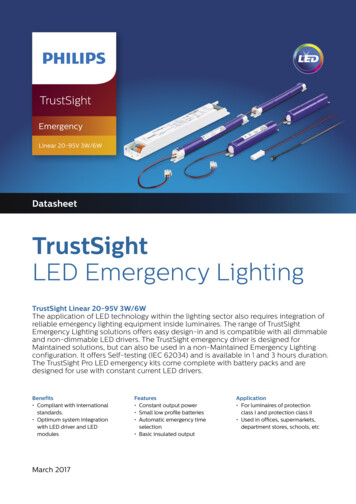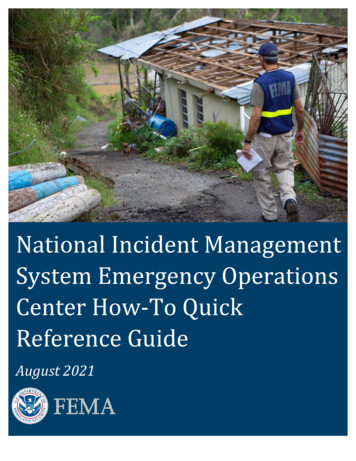
Transcription
National Incident ManagementSystem Emergency OperationsCenter How-To QuickReference GuideAugust 2021
This page intentionally left blank
Table of ContentsIntroduction .91.Purpose .91.1.NIMS Compliance and Integration . 9What Is an EOC?. 101.Hallmarks of an EOC . 10Preliminary Assessments. 121.Hazard and Vulnerability Assessment . 122.Resilience Analysis and Planning Tool . 123.Capability Assessment . 133.1.Interagency Coordination . 133.2.Multiagency Coordination Groups . 143.3.Private Sector . 153.4.EOC Staffing Requirements and Structure Type . 163.5.EOC Facility Support . 203.6.Plans and Procedures . 203.7.Lifelines . 21Site Selection . 221.General Considerations . 221.1.Vulnerability . 221.2.Central Location and Proximity to Key Personnel . 231.3.Traffic Flow and Congestion . 231.4.Accessibility . 231.5.Parking . 231.6.Communications . 231.7.Security . 241.8.Expandability . 241.9.Community-Based Design . 243
2.1.10.Alternate Sites . 251.11.Existing EOC Sites. 25Mitigation Considerations . 252.1.Natural Hazards. 252.2.Technological and Human-Caused Hazards . 25EOC Capabilities and Requirements . 261.2.3.4.Determining Personnel Space Requirements . 261.1.EOC Functions . 261.2.Space Requirements . 261.3.Additional Personnel Space Requirements . 271.4.Sustained Operations . 27Communications Requirements . 272.1.Interoperability . 272.2.Telecommunications (Including Teleconferencing, Videoconferencing, TextMessaging and Fax) . 282.3.Public Safety Radio . 28IT Requirements. 283.1.Internet Connectivity . 293.2.Computer Systems . 293.3.Audiovisual Support . 30Supplies and Equipment Requirements . 304.1.Furniture and Office Equipment . 304.2.Food Supply . 304.3.Medical and Sanitary Supplies . 304.4.Status and Situation Boards. 304.5.Administrative Supplies . 314.6.Support Services . 31Room Design Features . 321.Design Considerations . 321.1.Basic Room Designs . 324
2.3.1.2.Emergency Power . 331.3.Uninterruptible Power Supply . 341.4.Physical Access . 34Considerations for Multiuse Facilities . 352.1.Ancillary Space and Storage Areas . 352.2.Operations Room. 352.3.Classroom and Training Areas . 352.4.Meeting Rooms . 35Floor Plans . 36Information Management Systems . 371.2.3.Information/Data Management Tools . 371.1.Geospatial Data and Analysis Capability . 371.2.Crowdsourcing in Emergency Management . 381.3.Hazard Prediction and Monitoring Capability . 381.4.Crisis Information Management System . 391.5.Personnel Qualification and Certification System . 39Infrastructure for Communications and Data Management . 402.1.Adequate Numbers of Phones, Multifunction Copy/Scan/Print/Fax Devices, Copiers,Computers . 402.2.Secure Communications . 40Cybersecurity. 40EOC Management . 421.Standard Operating Procedures . 421.1.Authority . 421.2.Elected Officials and Senior Leaders . 421.3.Conditions for Activation . 431.4.Notice Events . 431.5.Notifications. 431.6.Setup . 431.7.Deactivation . 445
1.8.Annual Review . 441.9.Testing and Exercising Activation Procedures . 44Planning, Training and Exercises. 451.2.Planning . 451.1.The Preparedness Cycle . 451.2.Incident Action Planning . 46NIMS Training and EOCs . 462.1.3.EOC Training Progression . 46Exercises and EOCs . 493.1.HSEEP Principles . 493.2.Exercise Types . 503.3.Equipment Checks . 503.4.Evaluation and Improvement . 51Resource Management During an Incident . 521.Identifying Requirements . 532.Ordering and Acquiring . 532.1.Resource Requests . 532.2.Incident Assignments . 54Abbreviations . 55Glossary . 58References and Resources . 72COVID-19 Pandemic Operational Guidance . 72Cybersecurity . 72Emergency Support Function (ESF). 72FEMA National Training and Education Division (NTED). 72ICS Resource Center . 73Incident Action Planning Guidance . 73Lifelines . 736
National Incident Management System (NIMS) . 73National Qualification System (NQS). 73NIMS Training Program . 74NQS EOC Skillsets and EOC Skillsets User Guide . 74OneResponder . 74Threat and Hazard Identification and Risk Assessment (THIRA) . 74Vulnerability Assessment . 74Annex . 751.Facility Features . 772.Survivability . 793.Security . 804.5.6.3.1.Facility . 803.2.Communications/Networks . 803.3.Personnel . 81Sustainability. 824.1.Facility . 824.2.Communications/Networks . 82Interoperability . 845.1.Communications . 845.2.Procedures . 855.3.Training . 85Flexibility. 866.1.Facility . 866.2.Communications/Networks . 877.Other Considerations . 898.Additional Comments and Other Key Information . 907
This page intentionally left blank8
IntroductionThe routine, day-to-day management of government differs greatly from emergency operations.During an emergency, effective decision-making relies on leaders’ ability to collect emergencyrelated information, which requires close coordination between key officials from a variety ofagencies and departments.Having a central facility such as an Emergency Operations Center (EOC), from which leaders cancoordinate and direct emergency efforts, is essential for emergency response and recovery. 1Governments, jurisdictions, municipalities, nongovernmental organizations (NGO) and members ofthe private sector, at all levels, should prepare for the possibility of an emergency that willsignificantly change operating procedures. Governments must be ready to direct and controlemergency operations.1.PurposeThe purpose of this all-hazards how-to guide is to provide state, local, tribal and territorial (SLTT)jurisdictions with information and guidance related to setting up, operating, maintaining anddeactivating an EOC that successfully meets the jurisdiction’s needs. This guidance applies an allhazards approach in its concepts, processes and principles. FEMA recognizes that certain hazards(such as COVID-19) may have specific implications, precautions and instructions that take effectunder certain conditions and threat environments.1.1.NIMS Compliance and IntegrationLeaders should consider the National Incident Management System (NIMS) framework andprinciples when developing an EOC. Using appropriate terminology is especially important forensuring consistency among jurisdictions at all levels of government.1 An exception to the need for a central location could be when planning for a pandemic, in which case leaders shouldconsider telecommuting or other policies that impose physical distance.9
What Is an Emergency OperationCenter (EOC)?An EOC is a physical or virtual location from which leaders of a jurisdiction or organization coordinateinformation and resources to support incident management activities (on-scene operations). An EOCmay be housed in a temporary facility or in a permanently established, central facility—perhaps abuilding that supports another government agency within the jurisdiction. EOC team structure andcomposition can vary widely.Deciding how to organize the EOC staff depends on factors such as the jurisdiction’s ororganization’s mission, authorities, staffing, partner/stakeholder agencies represented, EOCfacilities, communications capabilities and political considerations. For more information on EOCstructures and organization methods, see the Capability Assessment section of this guide.Jurisdictions establish EOCs to meet their unique requirements and needs, so no two EOCs haveexactly the same design. Some jurisdictions see the EOC as the nerve center and tactical hub forincident response. Others see an EOC as a resource coordination center that locates and deploysresources but does not direct tactical-level responses. Yet others envision an EOC as a room withstadium seating and rows of desks facing large screens—or as an open room with tables and chairsfor each Emergency Support Function (ESF). In the end, the structure and functions largely dependon the requirements of the individual jurisdiction.Primary functions of staff in EOCs, whether virtual or physical, include: Collecting, analyzing and sharing information Supporting resource needs and requests, including allocation and tracking Coordinating plans and determining current and future needs In some cases, providing coordination and policy direction1.Hallmarks of an EOCAn EOC is a coordination structure for collecting, analyzing and sharing information. During anincident, the EOC collects a large amount of information from multiple sources. Analysts fromappropriate stakeholder organizations review and interpret the data. The analysts then distill theinformation into reports so that decision makers have the best possible intelligence when decidinghow the jurisdiction will respond. Further, the EOC communicates information to response teammembers in the field, giving them greater insight into their work.All EOCs have the following three hallmarks:10
An EOC supports resource needs and requests, including allocation and trackingAs incidents become more complex or cover growing geographic areas, an agency’s ability torespond may become overwhelmed. An EOC serves as a single source for requesting additionalresources from across the jurisdiction and from surrounding jurisdictions. Whether the EOC givestactical instructions or dispatches resources requested from tactical commanders depends on thejurisdiction. However, all EOCs can analyze data, identify shortfalls, find resources, dispatchresources and monitor their return in order to give personnel on the ground the support they need todo their job. An EOC coordinates plans and determines current and future needsAn EOC is a synthesis of multiple departments and agencies that work together in a coordinatedfashion. EOC personnel facilitate a standard planning process to achieve EOC objectives. They alsoprovide a range of planning services to address current needs and anticipate and devise ways tomeet future needs. An EOC provides coordination and policy directionAn EOC helps to integrate stakeholders and works with senior officials to facilitate the developmentof policy direction for incident support. EOC personnel work with legal counsel, authorize relevantprotocols and procedures for response and coordination, and ensure the dissemination of timely,accurate and accessible information to the public. In addition, the staff in an EOC liaise with othergovernment agencies at all levels, including federal and SLTT.11
Preliminary AssessmentsBefore establishing an EOC, jurisdictions conduct hazard and vulnerability assessments andcapability assessments to ensure that the facility can withstand the impacts of potential hazards andcan support a coordinated response to these hazards.1.Hazard and Vulnerability AssessmentEach jurisdiction conducts a hazard and vulnerability assessment to identify natural, technologicaland human-caused threats and hazards and rank them based on their likelihood and potentialconsequences. Jurisdictions use the assessment results to determine the EOC’s physical design,ideal location and necessary capabilities. This work is essential because an EOC must be designedto withstand the impacts of likely hazards. FEMA’s Threat and Hazard Identification and RiskAssessment (THIRA) provides detailed information on this process.2.Resilience Analysis and Planning ToolFEMA designed the Resilience Analysis and Planning Tool (RAPT) to help emergency managers atlocal, state and regional levels visualize and assess challenges to community resilience. ThisGeographic Information Systems (GIS) mapping tool includes the following: Data layers for hazards, such as seismic and flood risks Infrastructure data, such as fire station and hospital locations The 20 community resilience indicators identified in the Community Resilience Indicator Analysis(CRIA) 2, an analysis of peer-reviewed research on community resilience challenges in U.S.countiesRAPT allows users of all GIS skill levels to assess county-level challenges to resilience and to tell avisual story of priority needs for a range of issues, such as the following: Populations that may have greater challenges because of socioeconomic characteristics orproximity to critical infrastructure Potential difficulties in reestablishing community lifelines after a disaster Community zoning or land use plans that conflict with local hazardsFor more information about CRIA, visit ema community-resilienceindicator-analysis.pdf.212
3.Capability AssessmentThe next step in planning an EOC is to identify the capabilities the EOC must have in order tocoordinate a response to the identified hazards and risks. A capability assessment is a fundamentalconcept of emergency planning at all levels of government. The EOC capability assessment includesthe following considerations:3.1.Interagency CoordinationThe Command and Coordination component of NIMS provides the user community with systems,principles and structures. Incident Command and Coordination consists of four areas ofresponsibility: Tactical activities to apply resources on scene Incident support, typically conducted at EOCs:o Operational and strategic coordinationo Resource acquisitiono Information gathering, analysis and sharing Policy guidance and senior-level decision-making Outreach and communication with the media and public to keep them informed about theincidentLocal authorities handle most incidents using communications systems, dispatch centers andincident personnel within a single jurisdiction. Larger and more complex incidents may begin with asingle jurisdiction but rapidly expand to multijurisdictional and multidisciplinary efforts requiringoutside resources and support.EOC staff members coordinate with agencies/organizations inside and outside their jurisdiction thatmay provide assistance during an emergency. These include county, regional and state stakeholderswho have response and recovery roles and responsibilities, or who represent other entities (forexample, port authorities, mass transit agencies, regional task forces and critical infrastructureowners and operators) and assist through formalized agreements. County EOCs typically coordinatedirectly with state EOCs. State EOCs function much like county EOCs, except they are also in directcoordination with federal agencies.Multiagency coordination and Unified Command requirements influence EOC design and spacerequirements. Leaders should consider several factors during the EOC design phase: During large incidents, outside agencies and organizations often send representatives to theEOC. These team members may need specialized communications equipment, power sourcesand parking for support vehicles.13
An EOC may need to expand as an incident becomes more complex. To avoid functionalityissues, design the EOC to accommodate expanding on-site personnel numbers. The size of the jurisdiction’s population may play a role in how large the facility should be. Jurisdiction size and population growth both play into interagency coordination, since agenciesgrow with the population.3.2.Multiagency Coordination GroupsMultiagency Coordination Groups (MAC Groups), sometimes called Policy Groups, typically consist ofagency administrators or organization executives or their designees. MAC Groups provide policyguidance to incident personnel, support resource prioritization and allocation, and enable decisionmaking among elected and appointed officials and senior executives—both those in otherorganizations and those directly responsible for incident management.MAC Groups coordinate these four areas across the different NIMS functional groups: IncidentCommand System (ICS), EOC, MAC Groups and Joint Information Systems (JIS). The Command andCoordination component describes these multiagency structures and explains how various elementsoperate at different levels of incident management and interface with one another.For more information on the organizational context of the NIMS Command and Coordinationcomponent, see Figures 1 and 2 below, copied from FEMA training course E/G/L 0400: AdvancedIncident Command System for Command and General Staff – Complex Incidents.Figure 1. NIMS Components: Command and Coordination14
Figure 2. NIMS Components: Multiagency Coordination GroupNote: Do not confuse this type of interagency coordination with the NIMS Multiagency Coordinatio
exactly the same design. Some jurisdictions see the EOC as the nerve center and tactical hub for incident response. Others see an EOC as a resource coordination center that locates and deploys resources but does not
